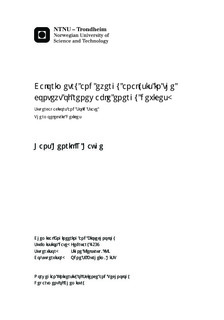| dc.description.abstract | The motivation for this master thesis is to establish methods for thermal characterization of technolog- ical devices necessary in a renewable energy society. More specifically in this thesis supercapacitors and thermoelectric generators have been investigated, using irreversible thermodynamics to descibe the observed device features.In the experimental work regarding the analysis of supercapacitors, stacks of four Maxwell PC10 series supercapacitors, connected in series, were examined by means of isothermal calorimetery, measurements of the thermal conductivity of the constituent materials, and dissecations. Using a stack of four supercapacitors, instead of a single supercapacitor, gave access to the internal temperature gradient, without having to alter the internal configuration. Two models were developed in order to determine the effective thermal conductivity of the stack. The first model is based on the second degree temperature gradient, measured by thermocouples embedded between the supercapacitors, resulting in an effective thermal conductivity, λ(stack), between 0.5 W/K m and 1.0 W/Km, depending on the compaction pressure. The second model, based on summing the thermal resistivities of the constituent materials, revealed an effective thermal conductivity of λ(stack) = 0.53 ± 0.06 W/Km. Studying the entropy production of the supercapacitors, the effective thermal conductivity, λ(stack), is found to be the decisive constructional factor, for minimizing the entropy production. The activated carbon material of the electrodes, was determined to be the constituent material with the highest contribution to the effective thermal resistivity of the device, and hence the loss of exergy in the energy storing process.In the experimental procedures of thermoelectric modules, TEP-1264-1.5 modules supplied by Thermo- Gen AB, were investigated. In the experimental procedures, the obtainable temperature gradient within the calorimeter proved to be too small for load experiments, and polarization of the heat was found to cause uncompensatable uncertainty in the measurement of the heat fluxes through the device, thereby making e.g. the figure of merit an unobtainable value. From the experiments the Seebeck coefficient of the module was found to be η(S) =37±7mV/K, and the isothermal ohmic resistivity of the device was determined to increase linearly temperature, described as R = 1.394 ± 0.007 T , where the unit of the ohmic resistance is [Ω], and T is the average temperature across the device, in [◦C]. Both results are in accordance with values obtained by Takla [2].The most important mean, in order to further improve this type of experimental investigations of the energy devices, is to obtain higher precision in the heat flux through the interface between the calorimeter, and the respective devices. | nb_NO |

